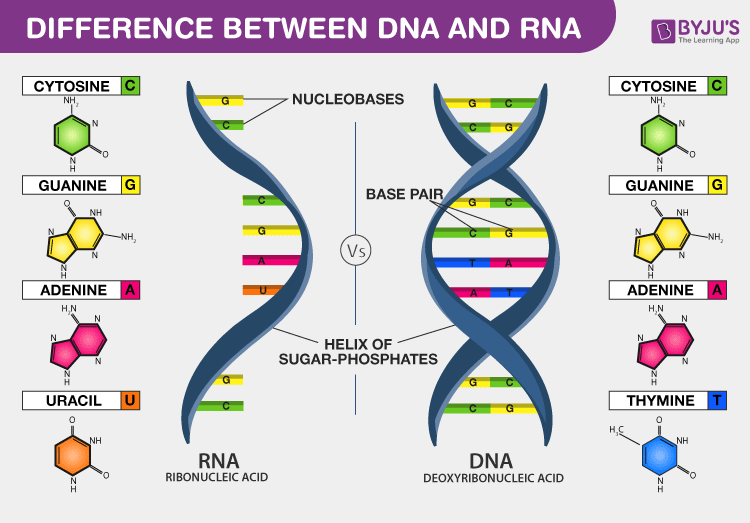Explain How Rna Differs From Dna in Structure and Function
Ribosomal RNA decodes the message in the ribosome to make protein. RNA is also referred to as an enzyme as it helps in the process of chemical reactions in the body.

Dna Vs Rna Introduction And Differences Between Dna And Rna
There are 3 main types of RNA.

. It is a blueprint for all genetic information contained within an organism. Nitrogen Base DNA uses four kinds of nitrogenous bases. TRNA has anti-codon while DNA does not.
DNA is a double-stranded molecule which serves as the genetic material of a cell. RNA also contains adenine guanine and cytosine bases. While DNA is a double-stranded helix double helix RNA is single-stranded and linear.
Both however are pyrimidines. 1 Single stranded mainly except when self complementary sequences are there it forms a double stranded structure Hair pin structure Double stranded Except for certain viral DNA s which are single stranded 2 Ribose is the main sugar The sugar moiety is deoxy ribose 3 Pyrimidine components differ. Describe the structure of DNA and explain how the structure of DNA supports the function of DNA.
These instructions are stored inside each of your cells distributed among 46 long structures called chromosomes. However whereas DNA. First week only 499.
Solution for Explain how the function of RNA differs from the function of DNA. There are three types of RNA and each is involved in protein synthesis. Solution for Briefly explain the structure and some functions of DNA RNA and a close relative adenosine triphosphate ATP in nucleic acid.
-replicates itself when dividing. Each comprises a different molecule of pentose sugar deoxyribose for DNA and pentose for RNA and a slightly different set of nitrogenous bases adenine guanine cytosine and thymine in DNA. DNA is the information molecule.
These chromosomes are made up of thousands of shorter segments of DNA called genes. RNA converts the genetic information contained within DNA to a format used to build proteins and then moves it to ribosomal protein factories. Bases that have a single ring structure thymine and cytosine What are the functions of DNA.
Describe the role of DNA and RNA in protein synthesis. Adenine guanine cytosine and uracil in DNA. The DNA has thymine shielded by methyl group which gives extra stability whereas RNA has uracil without any protecting group.
RNAs nucleotides contain ribose instead of deoxyribose. Biologists in the 1940s had difficulty in accepting DNA as the genetic material because of the apparent simplicity of its chemistry. DNA was known to be a long polymer composed of only four types of subunits which resemble one another chemically.
Protein synthesis is the process in which the correct amino acids are connected together in the order that is written on the gene. DNA uses nitrogen base like the letters in the alphabet to form a word. As has been said RNA has a different nitrogen base uracil than thymine and is composed of a different sugar than deoxyribose ribose.
The mRNA is translated. Basically they differ in their chemical structure. DNA is found in all living organisms and is a genetic material.
Basic Structure of RNA. The difference between RNA and DNA is based first of all on their constitution. It stores instructions for making other large molecules called proteins.
Hence is the name Ribonucleic acid. DNA replicates and stores genetic information. RNA on the other hand is involved in protein synthesis.
Thus DNA is most suited as a hereditary material than RNA molecule. There are two main types of nucleic acids DNA and RNA. Start your trial now.
DNA stands for deoxyribonucleic acid and RNA stand for ribonucleic acid. But instead of thymine they have another base called uracil U. Another difference is that RNA does not contain the base thymine T which is replaced by uracil U.
Messenger RNA copies information from the DNA strand and takes that message to be decoded. RNA is single stranded while DNA is double stranded RNA is a much shorter molecule One of RNAs bases is Uracil instead of Thymine. DNAs main job it to store information.
-stores an organisms genetic material in the nuclei. Adenine A guanine G cytosine C and thymine T. -provides code or template for the particular sequencing of amino acids that bond together and make a protein.
2 rows Structurally speaking ribonucleic acid RNA is quite similar to DNA. The DNA housed in the nucleus is too large to move through the nuclear membrane so it must be copied by the smaller single-stranded RNA transcription which moves out of the nucleus to ribosomes located in the cytoplasm and rough endoplasmic reti. RNA resembles the same as that of DNA the only difference being that it has a single strand unlike the DNA which has two strands and it consists of an only single ribose sugar molecule in it.
DNA is made up of DNA nucleotides whereas mRNA is made up of RNA nucleotides. Although both RNA and DNA are nucleic acids there are key differences in the structure and function of RNA and DNA. DNA consists of two strands arranged in a double helix.
Early in the 1950s DNA was first examined by x-ray diffraction analysis a technique for determining the three-dimensional. RNA is a copy of DNA but it is normally single-stranded. There are three types of RNA that are involved in protein synthesis are rRNA tRNA and micro RNA.
RNAs job is to use that information to make more DNA or protein to be used by the cell. MRNA is a single-stranded molecule which carries the.

Dna Vs Rna 5 Key Differences And Comparison Technology Networks

Dna Vs Rna 5 Key Differences And Comparison Technology Networks

No comments for "Explain How Rna Differs From Dna in Structure and Function"
Post a Comment